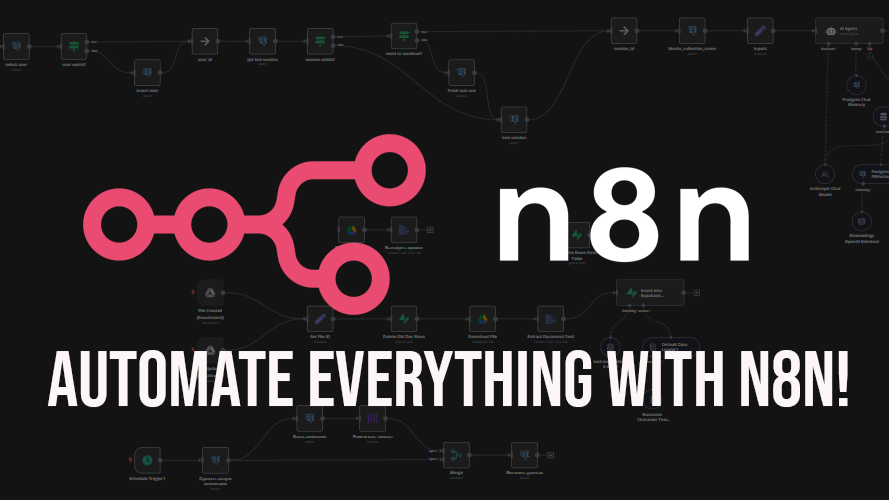
The Ultimate Guide to Building Smarter Workflows with n8n
In today’s fast-paced digital world, automation is no longer a luxury—it’s a necessity. From startups to large enterprises, businesses are constantly looking for ways to streamline processes, reduce manual effort, and improve efficiency. One tool that has been steadily gaining popularity in the developer and automation communities is n8n, an open-source workflow automation platform that empowers users to connect apps, APIs, and services seamlessly.
This guide will walk you through why n8n has become a favorite among developers, what makes it stand out from competitors, and how you can start leveraging it for your own projects.
Quick Snapshot
What is n8n?
n8n (short for “nodemation”) is a fair-code licensed workflow automation tool that lets you create powerful integrations without requiring extensive coding knowledge. It bridges the gap between “no-code” and “full-code” solutions, offering a middle ground where developers can easily customize workflows but also benefit from a visual, drag-and-drop interface.
With over 300 built-in integrations, n8n can connect services like Slack, GitHub, Google Sheets, Notion, and OpenAI, enabling endless possibilities for automating tasks across your tech stack.
Why Choose n8n?
Several features make n8n a strong contender in the workflow automation landscape:
- Open Source Flexibility
Unlike proprietary tools such as Zapier or Make (formerly Integromat), n8n is open source. This means developers have complete control over how they host, scale, and extend the platform. - Custom Node Creation
While n8n offers hundreds of integrations out of the box, developers can create custom nodes to support unique use cases or integrate with niche APIs. This makes it highly adaptable. - Fair-Code Licensing
n8n operates under a fair-code license. You can use it freely for personal or small projects, while larger-scale use requires a commercial license. This model ensures sustainability while keeping it accessible. - Cost Efficiency
Since n8n can be self-hosted, businesses can avoid the rising costs of SaaS automation platforms, especially when workflows grow complex.
Common Use Cases of n8n
The versatility of n8n allows it to be applied in countless ways. Here are some of the most popular use cases:
- Marketing Automation: Sync leads from landing pages into CRMs, trigger follow-up emails, and post campaign updates to Slack.
- Developer Workflows: Automate CI/CD pipelines, issue tracking, and notifications using integrations with GitHub, GitLab, and Jira.
- Customer Support: Connect chat platforms with help desk tools, route tickets automatically, and send updates to teams in real-time.
- AI-Enhanced Processes: Integrate with OpenAI to generate text summaries, draft responses, or even build intelligent chatbots.
- Business Operations: Automate invoice generation, data entry, and reporting by connecting apps like Google Sheets, Notion, and QuickBooks.
Getting Started with n8n
If you’re new to n8n, the good news is that setting it up is straightforward. You can run it via Docker, npm, or as a desktop app. For production use, Docker is the most common approach because of its simplicity and scalability.
Here’s a quick overview of the setup:
- Install Docker on your machine or server.
- Run n8n with a single command:
docker run -it --rm \
-p 5678:5678 \
-v ~/.n8n:/home/node/.n8n \
n8nio/n8n
Access n8n in your browser at http://localhost:5678.
From here, you can start creating workflows by dragging nodes onto the canvas, connecting them, and configuring triggers.
Best Practices for Using n8n
To get the most out of n8n, keep these best practices in mind:
- Start Small, Scale Later: Begin with simple workflows and gradually expand to more complex automations.
- Use Error Handling: Incorporate error triggers and logging to troubleshoot issues quickly.
- Secure Your Instance: Always use HTTPS and authentication if you’re hosting n8n publicly.
- Organize Workflows: Label nodes clearly and use sub-workflows to keep things tidy.
- Monitor Performance: For larger deployments, monitor execution times and resource usage.
n8n vs. Alternatives
It’s impossible to talk about
without mentioning alternatives like Zapier, Make, and IFTTT. So how does n8n stack up?
- Zapier: Great for non-technical users, but becomes costly as workflows scale.
- Make: Offers advanced features but is still proprietary and hosted.
- n8n: Open source, customizable, and cost-effective, especially for developers and teams that want full control.
If you’re looking for flexibility and long-term scalability, n8n stands out as a strong choice.
The Future of Workflow Automation
As businesses increasingly adopt AI and cloud-based services, the demand for flexible automation platforms will continue to rise. n8n is well-positioned to grow because it caters to both non-technical users (through its visual interface) and developers (through extensibility and open-source access).
We can expect to see more integrations, stronger AI capabilities, and a growing community of contributors pushing the platform forward.
Conclusion
Automation is no longer about convenience—it’s about staying competitive. Tools like n8n make it possible for businesses and developers to take control of their workflows, reduce repetitive tasks, and innovate faster. Whether you’re building marketing automations, managing DevOps pipelines, or experimenting with AI, n8n offers the flexibility to bring your ideas to life.
If you’re ready to explore workflow automation on your own terms, now is the perfect time to dive into n8n development and see how it can transform the way you work.


Average Rating